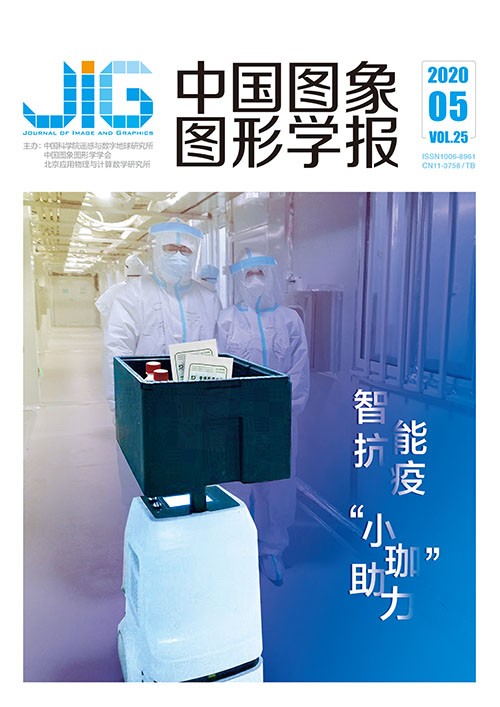
多相图像分割Vese-Chan模型连续最大流方法
摘 要
目的 多相图像分割是图像处理与分析的重要问题,变分图像分割的Vese-Chan模型是多相图像分割的基本模型,由于该模型使用较少的标签函数构造区域划分的特征函数,具有求解规模小的优点。图割(graph cut,GC)算法可将上述能量泛函的极值问题转化为最小割/最大流问题求解,大大提高了计算效率。连续最大流(continuous max-flow,CMF)方法是经典GC算法的连续化表达,不仅具备GC算法的高效性,且克服了经典GC算法由于离散导致的精度下降问题。本文提出基于凸松弛的多相图像分割Vese-Chan模型的连续最大流方法。方法 根据划分区域编号的二进制表示构造两类特征函数,将多相图像分割转化为多个交替优化的两相图像分割问题。引入对偶变量将Vese-Chan模型转化为与最小割问题相对应的连续最大流问题,并引入Lagrange乘子设计交替方向乘子方法(alternating direction method of multipliers,ADMM),将能量泛函的优化问题转化为一系列简单的子优化问题。结果 对灰度图像和彩色图像进行数值实验,从分割效果看,本文方法对于医学图像、遥感图像等复杂图像的分割效果更加精确,对分割对象和背景更好地分离;从分割效率看,本文方法减少了迭代次数和运算时间。在使用2个标签函数的分割实验中,本文方法运算时间加速比分别为6.35%、10.75%、12.39%和7.83%;在使用3个标签函数的分割实验中,运算时间加速比分别为12.32%、15.45%和14.04%;在使用4个标签函数的分割实验中,运算时间加速比分别为16.69%和20.07%。结论 本文提出的多相图像分割Vese-Chan模型的连续最大流方法优化了分割效果,减少了迭代次数,从而提高了计算效率。
关键词
Continuous max-flow method for multiphase segmentation Vese-Chan model
Wang Jie1, Pan Zhenkuan1, Wei Weibo1, Xu Zisen2(1.College of Computer Science and Technology, Qingdao University, Qingdao 266071, China;2.The Affiliated Hospital of Qingdao University, Qingdao 266003, China) Abstract
Objective Multiphase image segmentation, an extension of two-phase image segmentation, is designed to partition images automatically into different regions according to different image features. It is a basic problem in image processing, image analysis, and computer vision. Variational image segmentation Vese-Chan model is a basic model of multiphase image segmentation that can construct characteristic functions for different phases or regions using fewer label functions, thus producing small-scale solutions. Graph cut (GC) algorithm can transform the optimization problem of energy function into the min-cut/max-flow problem, which greatly improves computational efficiency. In the spatially discrete setting, the computational results of the min-cut method are influenced by the discrete grid, resulting in measurement errors. In recent years, the continuous max-flow (CMF) method was proposed. As a continuous expression of the classical GC algorithm, CMF can keep the high efficiency of the GC algorithm and overcome measurement errors caused by the discretization of the classical GC algorithm. On the basis of the framework of variational theory, the CMF method for multiphase image segmentation Potts model and two-phase image segmentation Chan-Vese model was proposed and studied. However, a CMF method for the Vese-Chan model has not been studied. Therefore, we propose a CMF method for multiphase image segmentation Vese-Chan model based on convex relaxation and study its computational effectiveness and efficiency. Method In this study, binary label functions are used to construct different characteristic functions for different phases according to the relationship between a natural number and a binary representation of partitioned regions. The characteristic functions are divided into two parts according to the value of binary expression, i.e., 0 or 1. The characteristic functions are different. The date term of the segmentation model is also divided into two parts. Therefore, multiphase image segmentation can be transformed into two-phase image segmentation. This model can be expressed as a symmetric form of label functions, which are beneficial to interpret and realize. We introduce three dual variables, namely, source flow, sink flow, and spatial flow field. Next, we rewrite the optimization problem of energy function for the Vese-Chan model, including the above three dual variables. Flow conservation conditions are obtained by solving minimum problems of energy function. The Vese-Chan model can be transformed into a continuous max-flow problem corresponding to the min-cut problem. To improve computational efficiency in the experiments, we likewise design the alternating direction method of multipliers (ADMM) by introducing Lagrange multipliers and penalty parameters for the proposed model. The main idea of alternating optimization is to solve the optimization problem of one variable by fixing other variables. Therefore, the optimization problem of energy function can be transformed into three simple sub-problems of optimization, which can be achieved and solved more easily. For example, to solve one sub-problem on the source flow variable, the sink flow variable and spatial flow field variable should be fixed. Three dual variables must be calculated and Lagrange multipliers should be updated at each step. All of these variable need projection to satisfy the range of values. When the energy error formula is satisfied, the computational iteration stops. To represent the boundary of images after segmenting, it is necessary to threshold convex relaxed label functions into binary label functions. Finally, we can obtain segmentation results according to the binary label functions. Result Numerical experiments are performed on gray and colored images. According to the area numbers of images, numerical experiments are divided into three parts: experiments using two binary label functions, three binary label functions, and four binary label functions. Segmentation results are represented by curves of different colors. In particular, to accurately represent the segmentation effects for complicated images, we obtain the approximate segmentation results. For the segmentation effectiveness, experimental results prove that the ADMM method and our proposed method have the same segmentation effectiveness for simple synthetic images. However, compared with ADMM, our proposed method is more accurate for complex images, such as medical and remote sensing images. Moreover, our method can achieve better separation for segmented objects and background. For the computational efficiency, we use two binary label functions to compare the efficiency of four gray images, including synthetic images, a natural image, and a medical image. The acceleration ratios of computational time for our proposed method are 6.35%, 10.75%, 12.39%, and 7.83%, respectively. For the experiment of three binary label functions, three gray images are compared, including synthetic images and a remote sensing image are compared. The computational times of our proposed method improve by 12.32%, 15.45%, and 14.04% for each image. For the experiment of four binary label functions, we compare two color images, including a natural image and a synthetic image. The computational times of our proposed method improve by 16.69% and 20.07%. In the experiments, our proposed method reduces the number of iterations and improves the convergence speed. By comparing the acceleration ratio of computational time with the increase of region phases or the complexity of the image, the advantages of the computational efficiency for our method are more evident. Conclusion Continuous max-flow method is used to solve the multiphase image segmentation Vese-Chan model. Numerical experiments are performed to demonstrate the superiority of our method in terms of computational effectiveness and efficiency for medical images, remote sensing images, and color images. Our method can be applied to multiphase segmentation for three-dimensional reconstruction of medical images in the future.
Keywords
multiphase image segmentation Vese-Chan model convex relaxation continuous max-flow method(CMF) alternating direction method of multipliers(ADMM)
|



 中国图象图形学报 │ 京ICP备05080539号-4 │ 本系统由
中国图象图形学报 │ 京ICP备05080539号-4 │ 本系统由